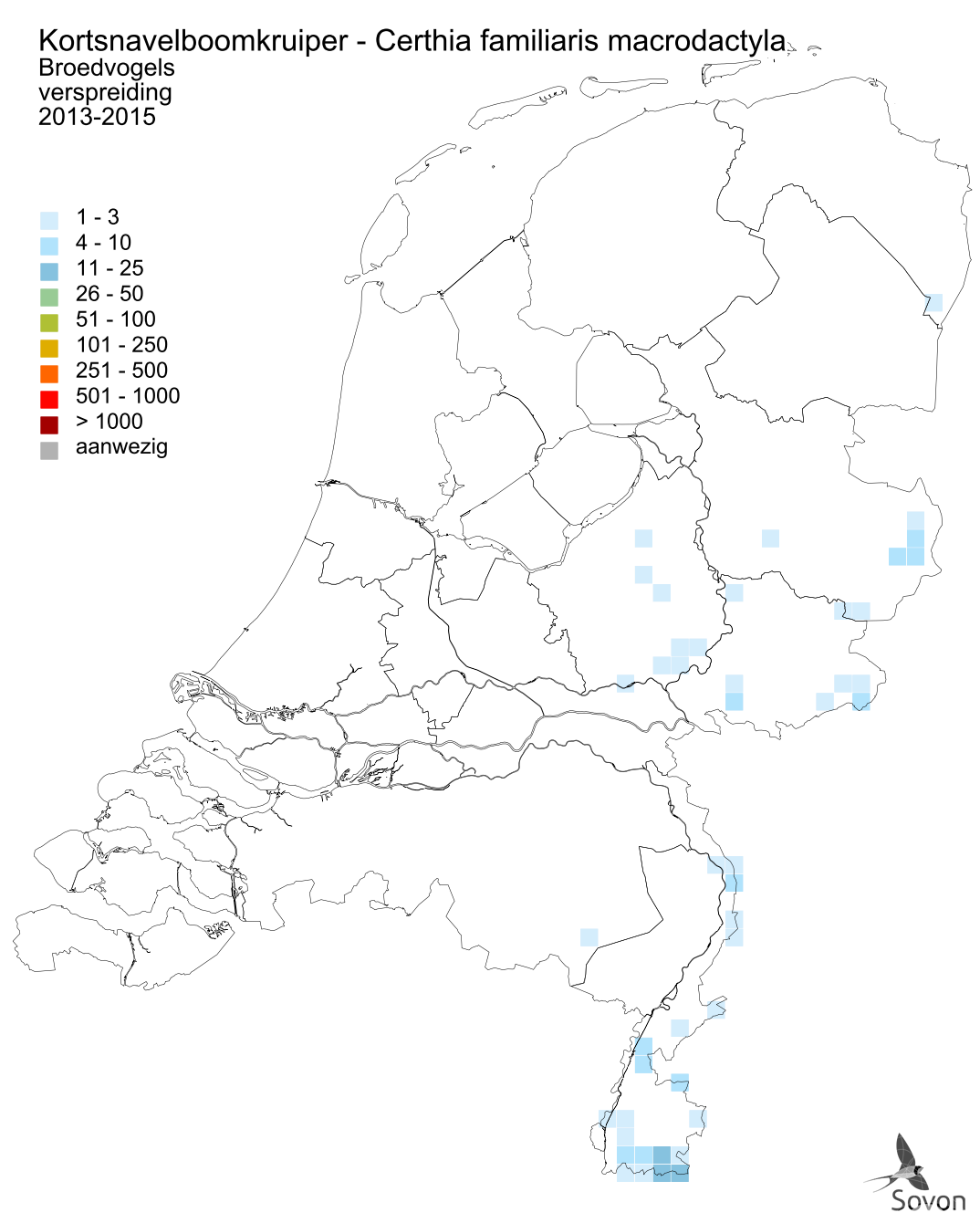Verspreiding en trends
Verspreiding

Deze kaart is gebaseerd op de Vogelatlas van Nederland (Sovon 2018). Per atlasblok van 5x5 km is er een schatting van het aantal broedparen gegeven.
Aantalsontwikkeling
Onvoldoende gegevens beschikbaar voor trendanalyse.
Broedsucces en overleving
Onvoldoende gegevens beschikbaar voor trendanalyse.
Seizoensvoorkomen
Onvoldoende gegevens beschikbaar voor trendanalyse.
Beschrijving voorkomen
Buiten broedtijd
Kortsnavelboomkruipers zijn vermoedelijk, net als Boomkruipers, heel standvastig. Ze blijven jaarrond min of meer in hun broedgebied. De waarnemingen op grote afstand daarvan, bijvoorbeeld op de Waddeneilanden, betreffen de Noord-Europese vorm (Taigaboomkruiper Certhia familiaris familiaris). Dit is een jaarlijkse maar zeldzame gast in vooral de noordelijke provincies.
Broedtijd
De Kortsnavelboomkruiper Certhia familiaris macrodactyla is de Midden-Europese vorm van de Taigaboomkruiper.. Het verspreidingsgebied van de Kortsnavelboomkruiper reikt inmiddels tot in ons land. De eerste broedgevallen vonden in 1993 plaats bij Vaals in Zuid-Limburg. De verspreiding bleef aanvankelijk beperkt tot de aan Duitsland grenzende delen van Limburg. Vanaf de eeuwwisseling werden ook andere delen van het land bezet, steeds in de grensstreek: Westerwolde (Groningen), Twente (Overijssel) en de Achterhoek, het Montferland en het Rijk van Nijmegen (Gelderland). Voorzichtig lijkt ook de sprong te zijn gemaakt naar de Veluwe en andere westelijker gelegen gebieden. De onopvallende, niet iedere vogelaar bekende zang maakt het lastig om de uitbreiding precies te volgen.
Vogelrichtlijn
Staat van instandhouding
De Vogelrichtlijn richt zich op de instandhouding van alle natuurlijk in Europa in het wild levende vogelsoorten waaronder de Kortsnavelboomkruiper.
Dit betekent dat de EU-lidstaten maatregelen moeten nemen om de populaties van deze soorten op een niveau te houden of te brengen dat met name beantwoordt aan de ecologische, wetenschappelijke en culturele eisen. Daaronder wordt onder andere een gunstige staat van instandhouding verstaan. Het begrip Staat van instandhouding is zo ongeveer synoniem voor de mate van duurzaamheid of gezondheid van een populatie van een soort.
De Vogelrichtlijn verlangt van de lidstaten dat ze leefgebieden voor vogels in voldoende omvang en kwaliteit in stand houden, waaronder door de aanwijzing van speciale beschermingszones ten behoeve van het Europese Natura 2000-netwerk. Voor de Kortsnavelboomkruiper zijn in Nederland geen speciale beschermingszones aangewezen. De landelijke populatie moet zich wel op een gunstig niveau kunnen handhaven.
Methodiek voor de bepaling van de Staat van instandhouding van vogels
broedvogel
De Staat van Instandhouding van de Kortsnavelboomkruiper als broedvogel in Nederland is gunstig.
| Beoordeling Staat van Instandhouding | ||||
| Verspreiding | Populatie | Leefgebied | Toekomst | Eindoordeel |
| gunstig | gunstig | gunstig | gunstig | gunstig |
Aangewezen gebieden
Er zijn geen gebieden aangewezen voor deze soort.
Telrichtlijnen
Broedvogels
Methode
Territoriumkartering
Tijd van het jaar
Begin februari t/m eind juni
Tijd van de dag
Aan begin broedseizoen vrijwel de hele dag actief (maar weinig opvallend bij matige/strenge vorst in de vroege ochtend), later vooral in de ochtend.
Datumgrenzen, normbezoeken en fusieafstand
| geldige waarnemingen | normbezoeken | minimaal vereist | fusie- | |||||||||
| adult | paar | terr | nest | migrant | 1 | 2 | 3 | seizoen | datumg | datumgrens | afstand | |
| . | . | X | X | 1 | 15-2 t/m 20-6 | 300 | ||||||
| X | X | . | . | 2 | 15-2 t/m 20-6 | 300 | ||||||
Aanwijzingen
Zingende vogels [broedcode 2] (pieken tussen half februari en half april), nestbouw [brc 9] (door vrouwtje) en ouders (transport) met voer [brc 14] (mannetje voert broedend vrouwtje, beide partners voeren jongen) of uitwerpselpakketje [brc 14] (beide partners). Zang duidelijk anders dan die van Boomkruiper: circa drie seconden durende strofe die begint met hoge korte tonen, gevolgd door lage fluittonen en soms afsluitende dalende triller en tweelettergrepig tsjoewie. Afspelen geluid op kansrijke locaties (oude, structuurrijke bossen met staand dood hout, veelal met eiken, beuken en/of meer dan 50 jaar oude sparren) onontbeerlijk om een goed beeld van het voorkomen te verkrijgen [vermelden als opmerking bij invoeren van broedcode omdat geluid afspelen de trefkans aanzienlijk vergroot].
